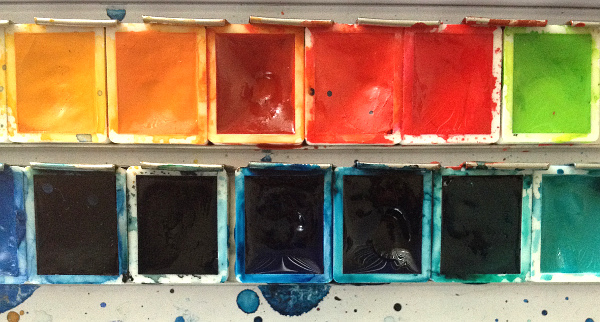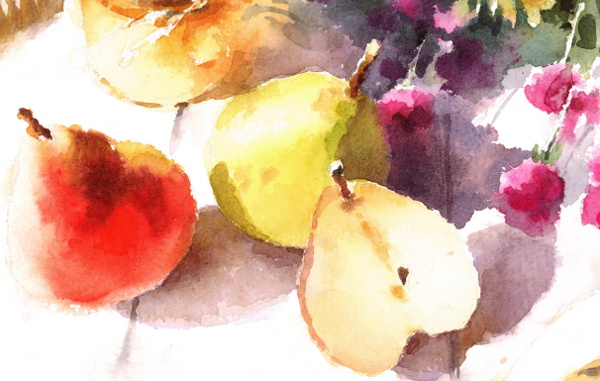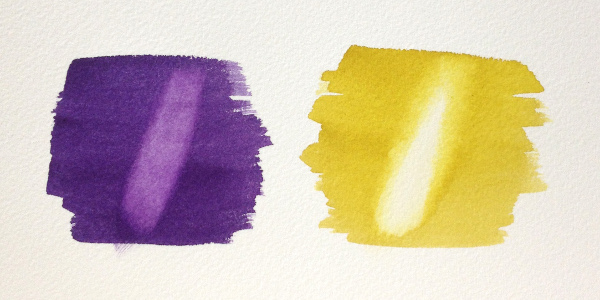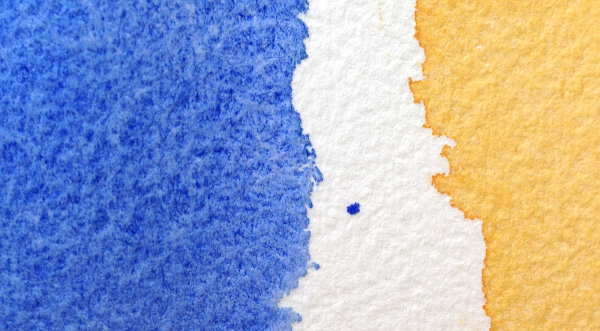While there’s nothing wrong with experimenting with watercolor paints, knowing their qualities and characteristics (and how they effect your painting) can help you create purposeful, compelling compositions. Read on to learn the basics watercolor properties before you start your next masterpiece.

What exactly are watercolor paints?
Watercolor paints basically consist of two main components: pigment and binding medium.
Pigments
Finely ground pigments, which give the paints their color, can be either organic or inorganic.
Organic pigments contain carbon, and they can be derived naturally from living matter or produced synthetically. For example, carmine used to be extracted from dried insects, while indigo and Indian yellow were originally made from plants. Nowadays, most natural organic pigments have been replaced with synthetic ones.
Inorganic pigments contain metals, and they can be mined directly from the Earth (examples include ochres, siennas and umbers), of manufactured in a lab (like cobalt blue and cadmium yellow).
Binding mediums
A binding medium is natural gum arabic or synthetic compounds. The binding medium is what makes watercolor paints different from other types of paint: For instance, oil paints are made with linseed oil and acrylic paints are made with acrylic polymer emulsion.
Manufacturers also add other necessary ingredients, such as plasticizer (usually glycerin), humectant (sugar syrup or honey), wetting agent and preservatives.

The beauty of watercolor lies in its unique qualities.
There are 4 basic characteristics of watercolor paints every artist should know about.
1. Transparency and opacity
Watercolor paints fall into one of four transparency categories:
- Transparent
- Semi-transparent
- Semi-opaque
- Opaque
Transparent watercolors allow the light to come through and reflect from the white paper, which makes the colors glow. Opaque watercolors, on the other hand, block the light from shining through, so they look thicker and somewhat cloudy. Semi-opaque and semi-transparent are somewhere in-between.
Transparency test
To find out where your paints fall on the spectrum of transparent to opaque, you can do a simple test. Draw a bold line with a black permanent marker; then stroke the color over that line. Opaque colors will be visible on the black line, while transparent colors will not appear.

As you can see from the picture, the cadmium lemon (on the left) is opaque, and quinacridone gold (on the right) is transparent.
2. Staining and non-staining paints
Staining watercolors immediately penetrate the fibers of the paper and stain it, so it’s difficult or impossible to lift the color off.
Non-staining watercolors, on the contrary, settle on the surface of the paper, and can be easily rewet and lifted when dry.
Staining test
To test your watercolors for staining quality, paint a patch of color and let it dry. Then, try to scrape off some of the paint with a stiff, wet brush. The amount of pigment that remains will tell you about the paint’s staining quality.
In the image below, the left patch is painted with winsor violet, which is made of dioxazine violet — a staining pigment. Even after trying to lift the pigment with a wet brush, some of the pigment remains.
On the right-hand side, you see green-gold — a non-staining pigment. After lifting some of the pigment with a wet brush, you can see the white of the paper again.

3. Granulating quality
Depending on the pigment, the particles in the paint can be heavy or light. Watercolor paints with heavier particles tend to separate from the water and collect in the tooth of the paper.
The picture below shows ultramarine blue on the left and quinacridone gold on the right. Ultramarine is a granulating (sedimentary) pigment. It looks grainy and creates a texture of its own. Quinacridone gold, on the other hand, has smaller pigment particles, so it flows evenly over the paper.

I’m a big fan of granulating paints, because it adds interest and texture to a painting.
4. Fugitive and non-fugitive paints
The longevity of your work depends on the lightfastness of your watercolor paints. A non-fugitive paint (or one with a good lightfastness rating) will not fade over time. A fugitive paint (or one with poor lightfastness) will fade quickly, so it’s best to avoid them.
The American Society of Testing and Materials (ASTM) established a standardized system that grades lightfastness on a scale from I – Excellent Lightfastness to III – Not Sufficiently Lightfast. Watercolors with an ASTM rating of I or II are considered non-fugitive, while paints with a rating of III are fugitive. The lightfastness rating of the paint can usually be found on the label.

What does it cost to attend classes in Auckland. NZ
Your article was very informative you did a great job and explaining the quality however you should also include the coding method used to identify these different characteristics.
Your article was very informative you did a great job and explaining the quality however you should also include the coding method used to identify these different characteristics characteristics.
Your lesson was very informative and I learned so much about the properties of watercolors. I am a beginner to watercolors and I am really loving the medium. Thanks for taking the time to explain it in such an easy, yet precise precise way.
I would have liked to have this info when I began painting with watercolor paints. I noticed some of these qualities, sometimes on the palette and sometimes on the paper, but had no terminology to identify them.
Very informative. Thanks!
Visit my website UwU or else you'll get hacked ? >;3 -Sincelery Liggma booty crak :o
okay
Very interesting!! Good info for comparing paints. Thanks!
Good summation and presentation. Very informative.